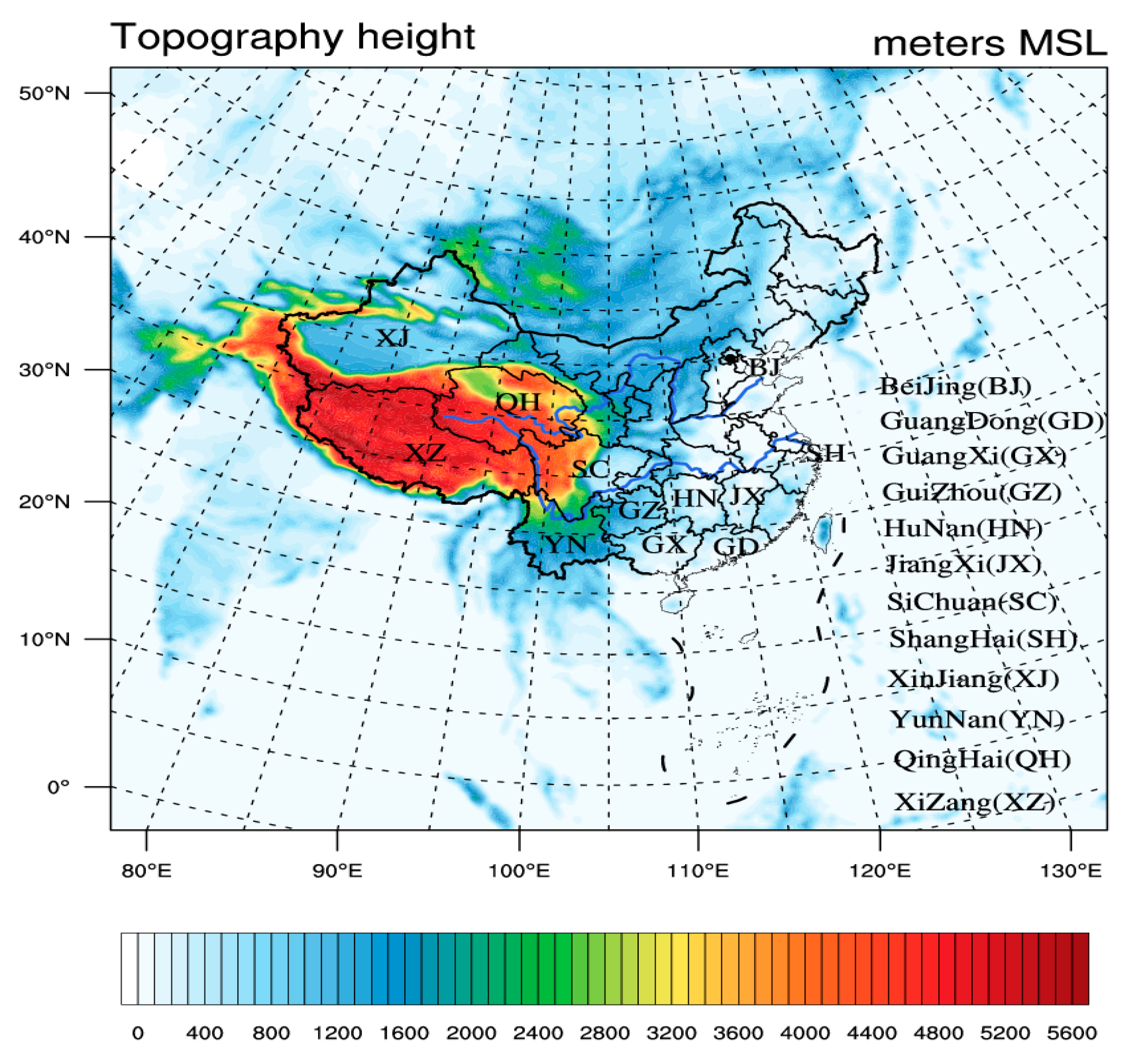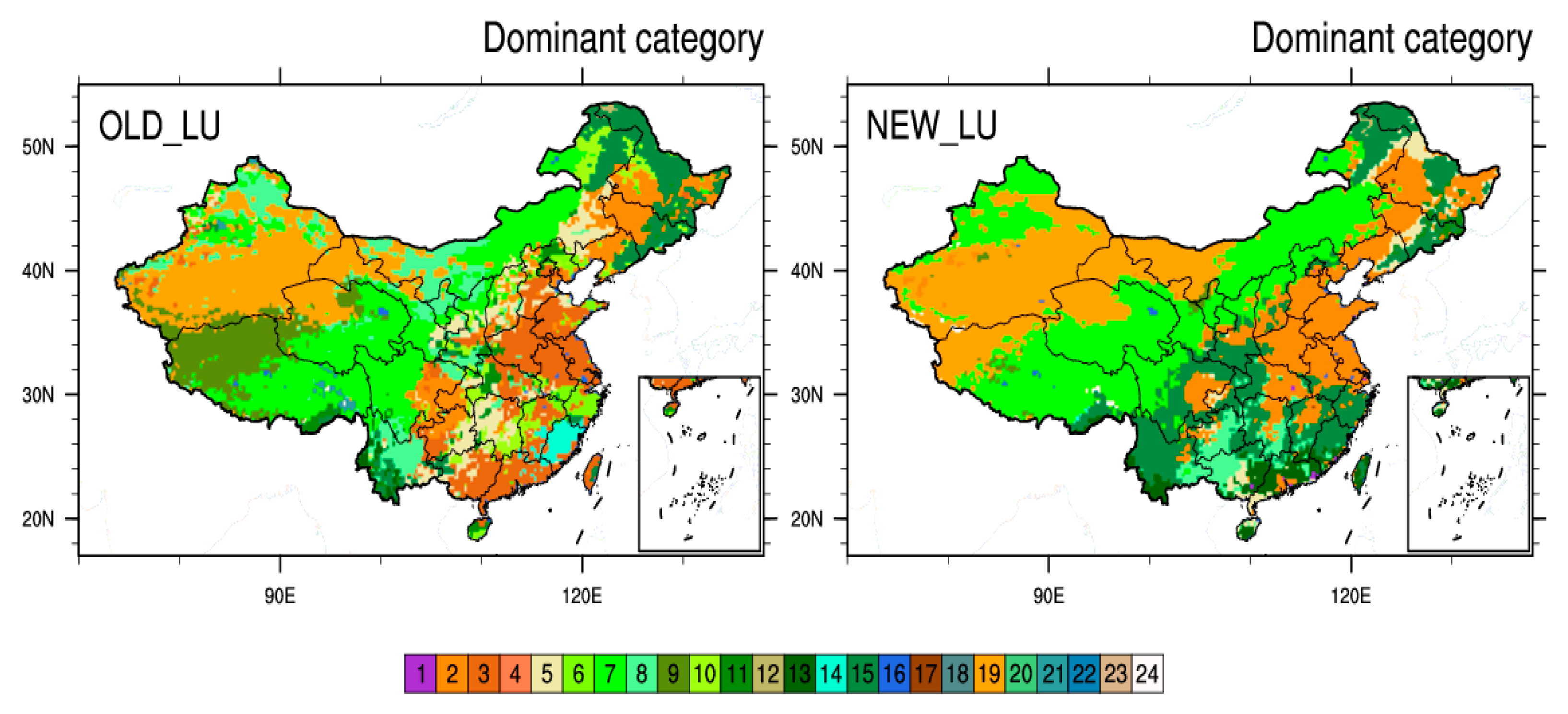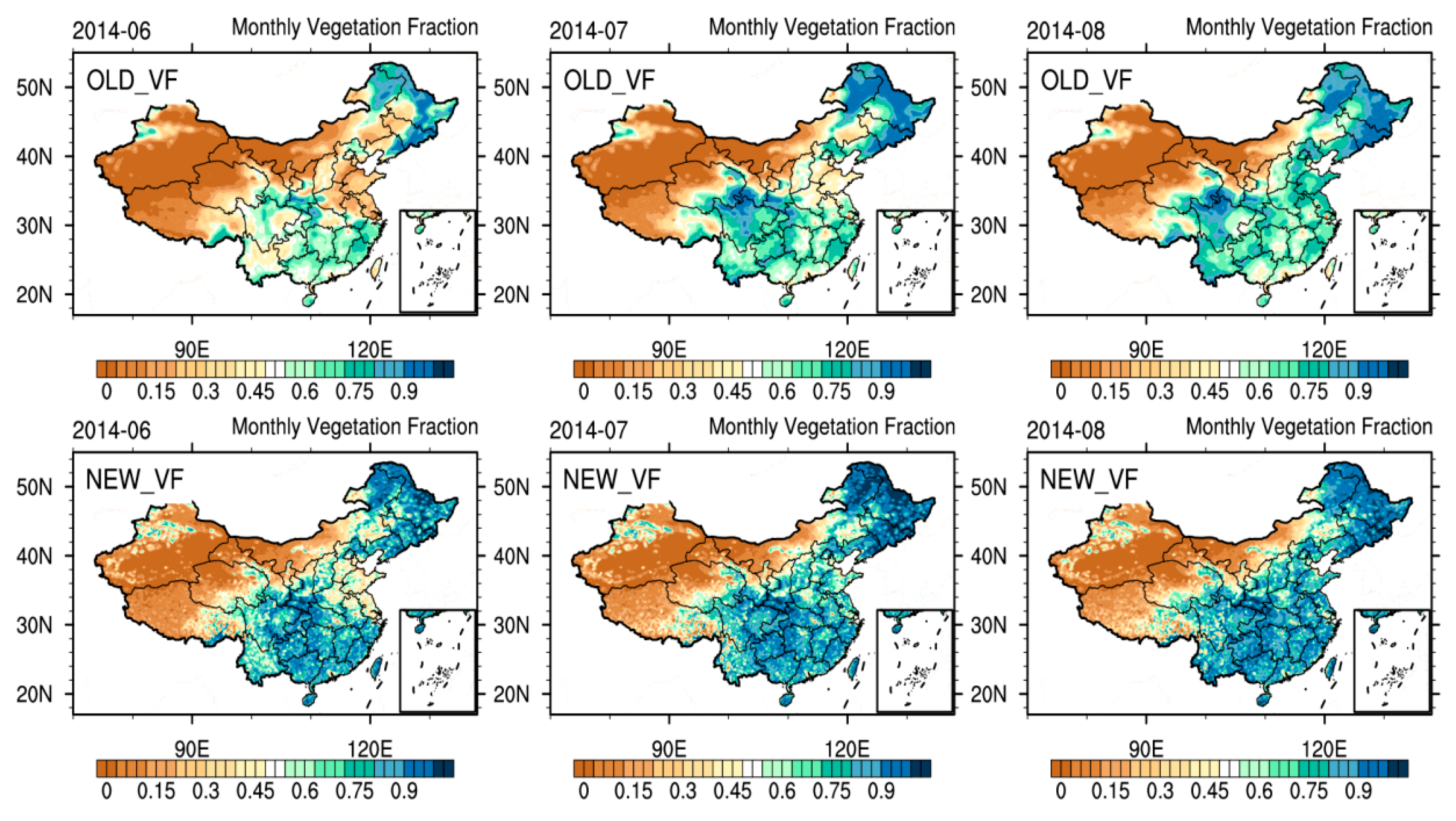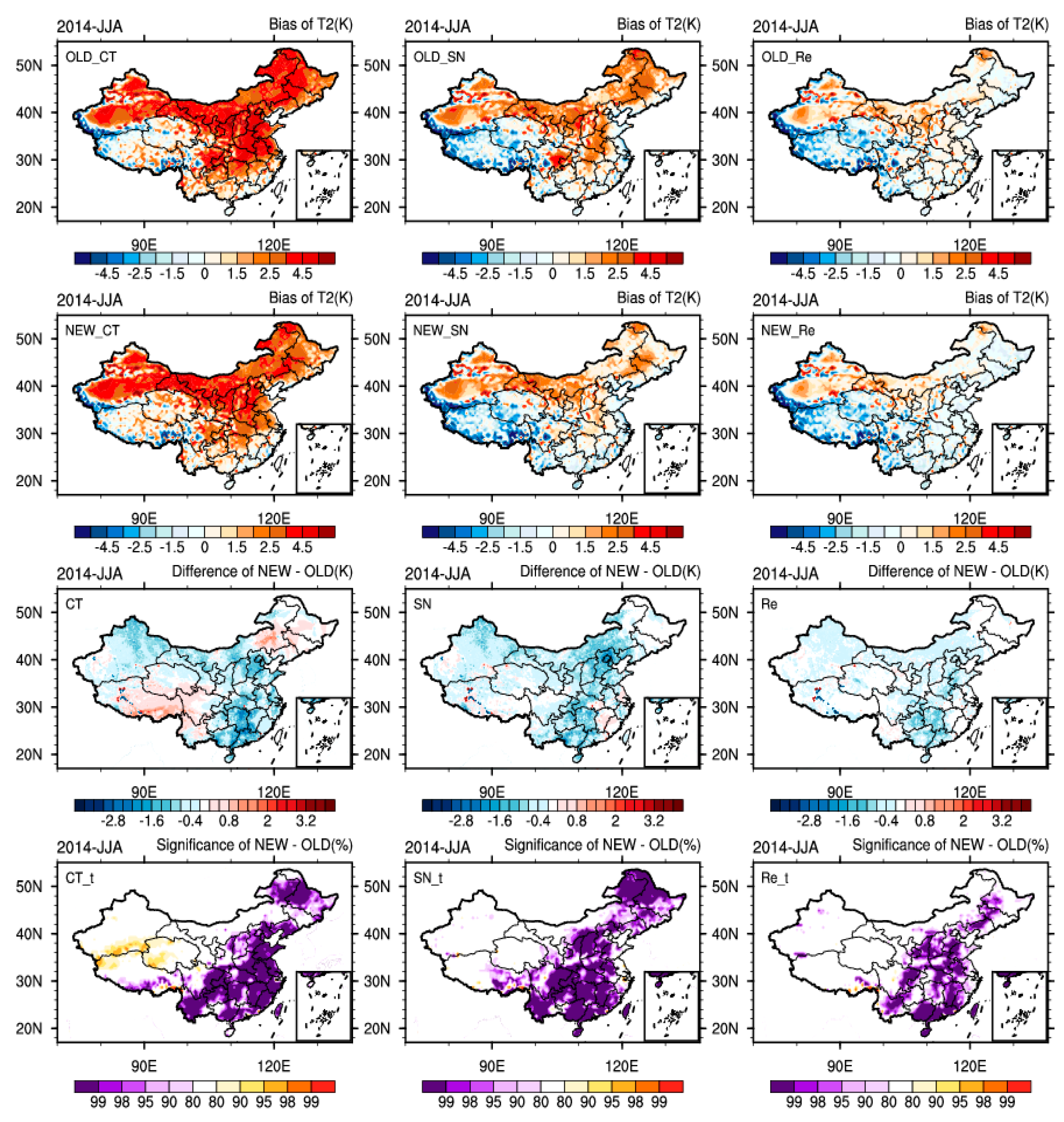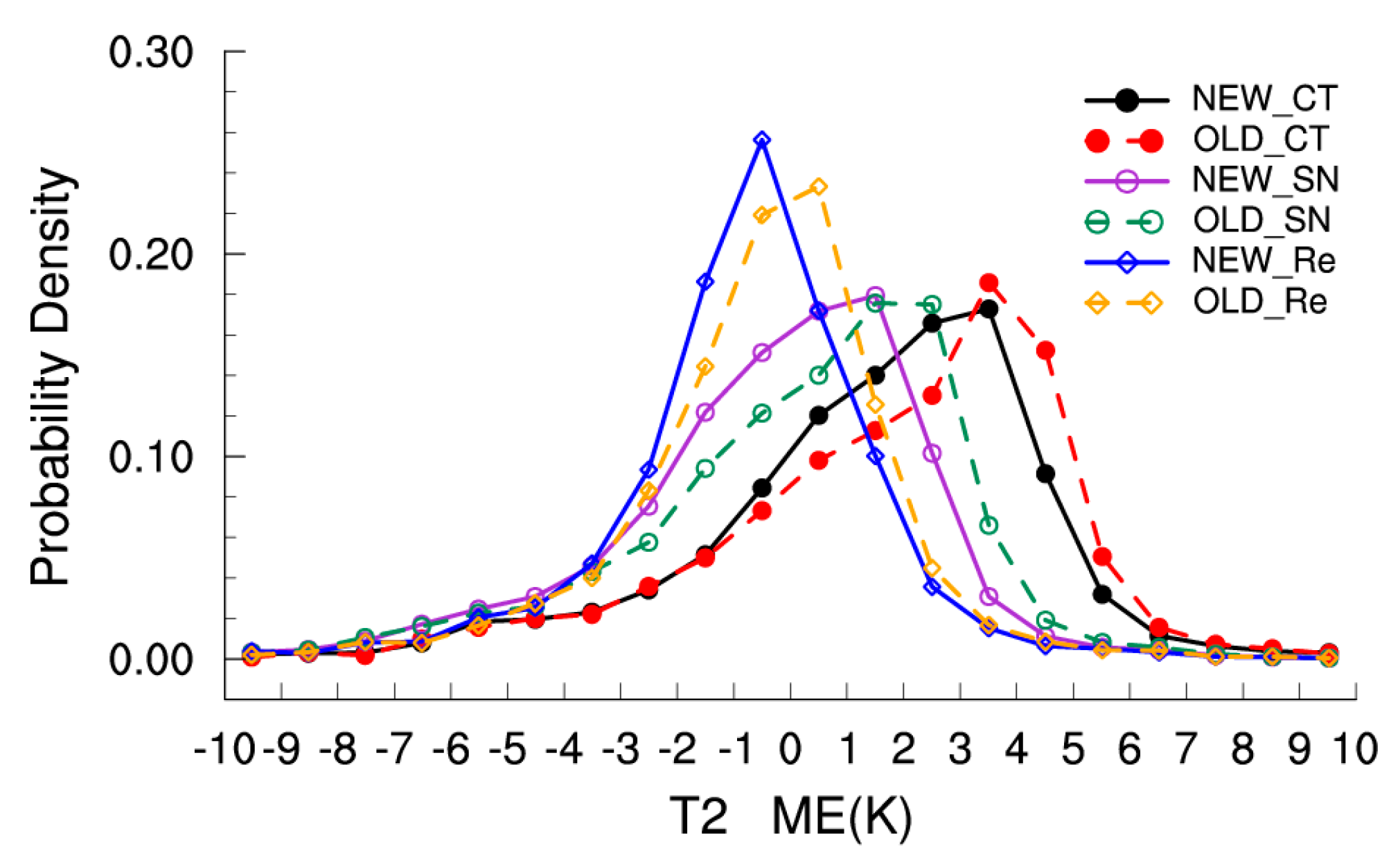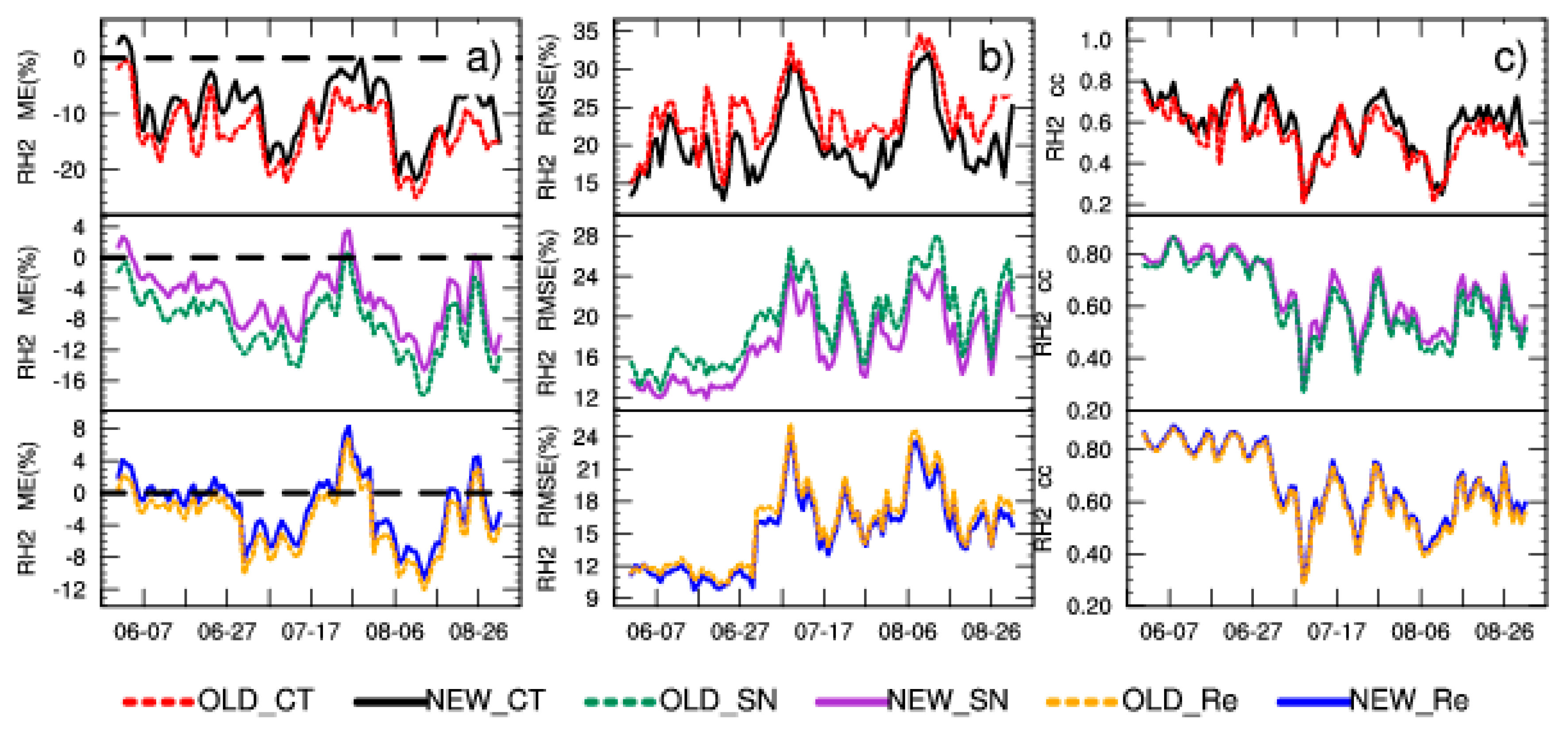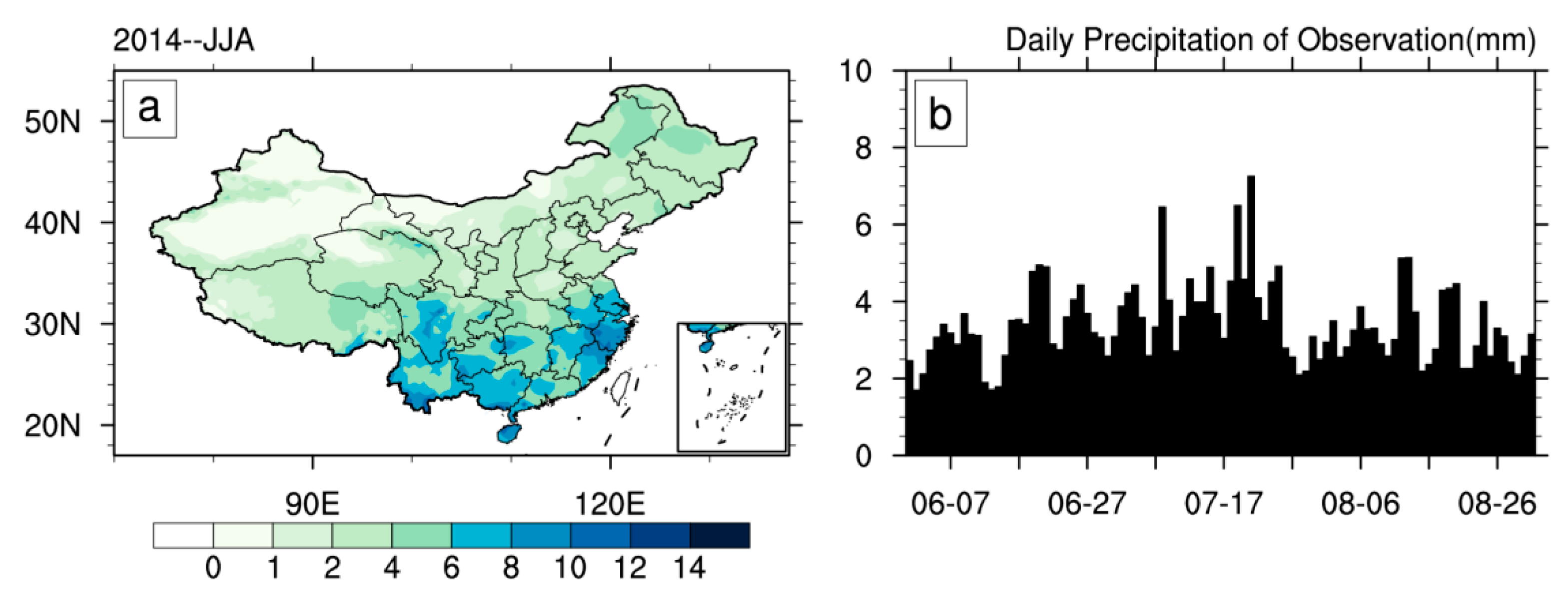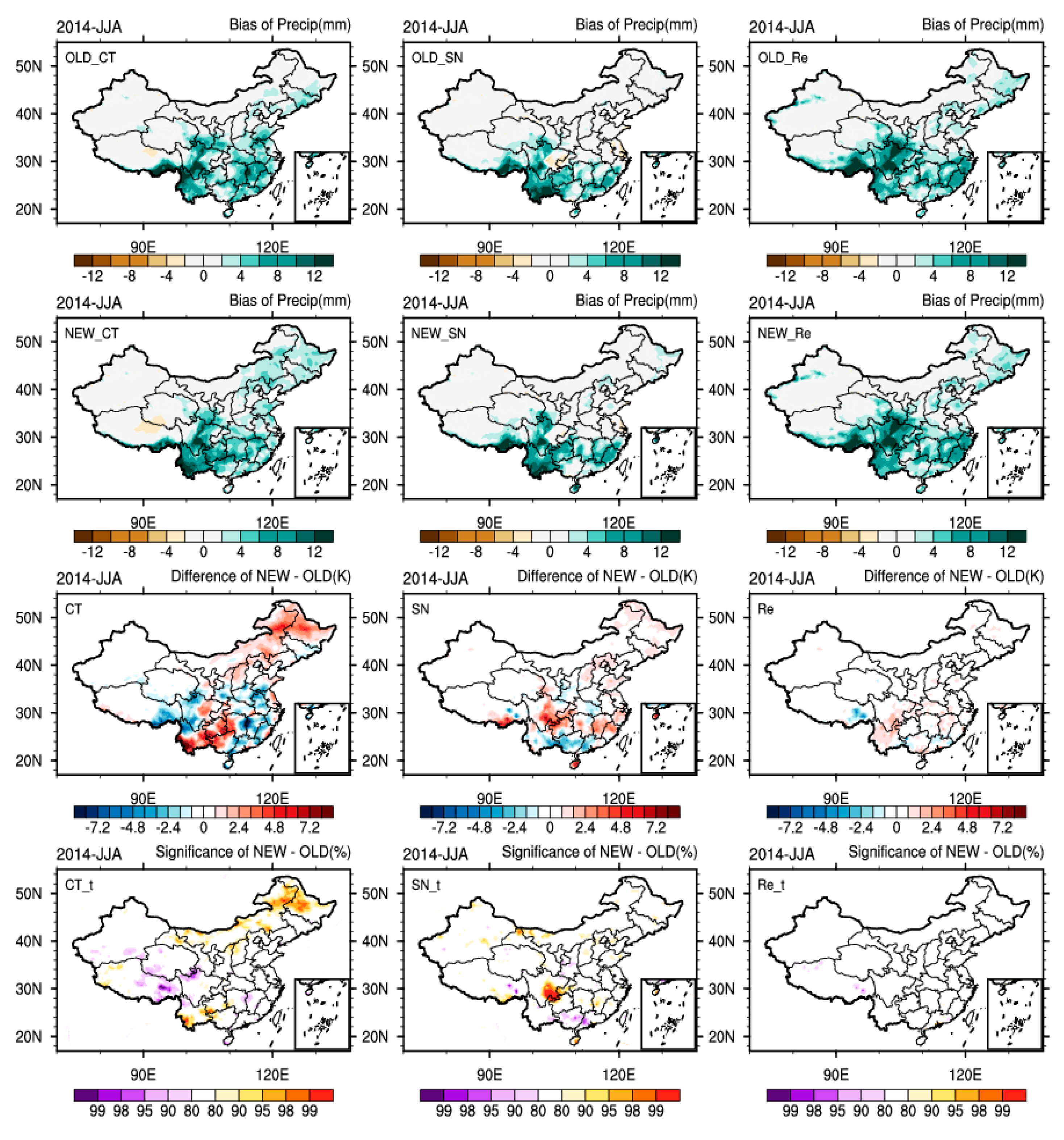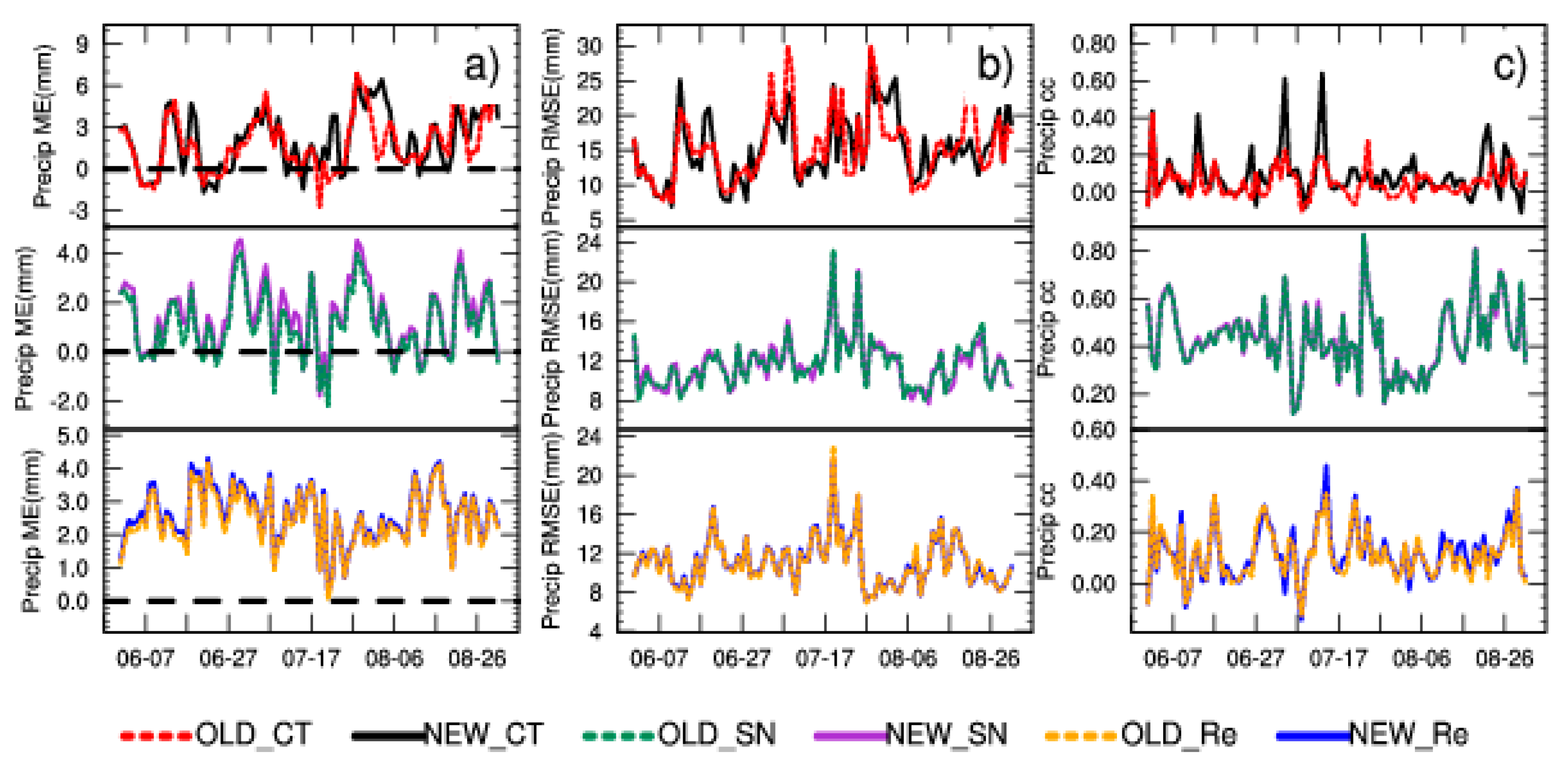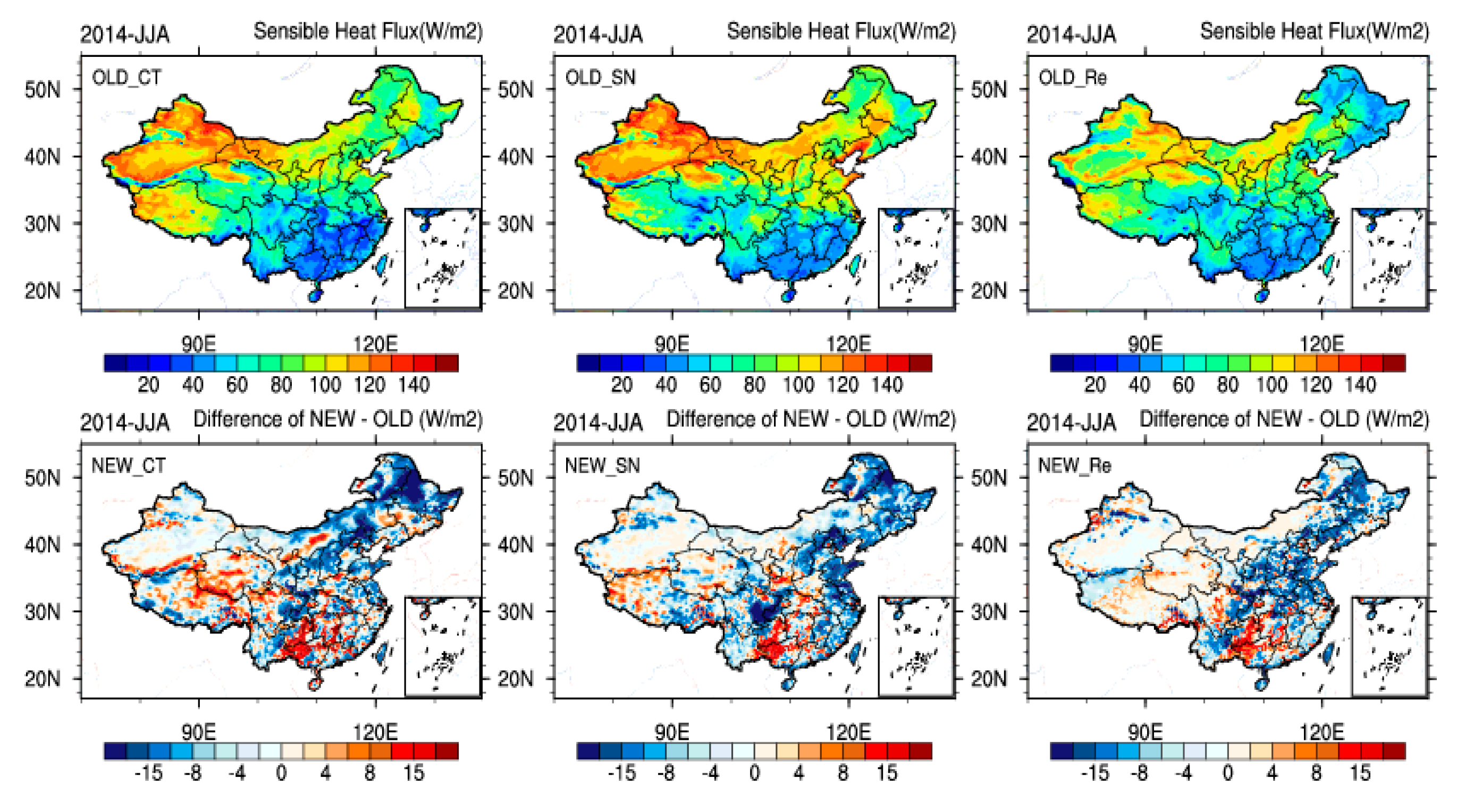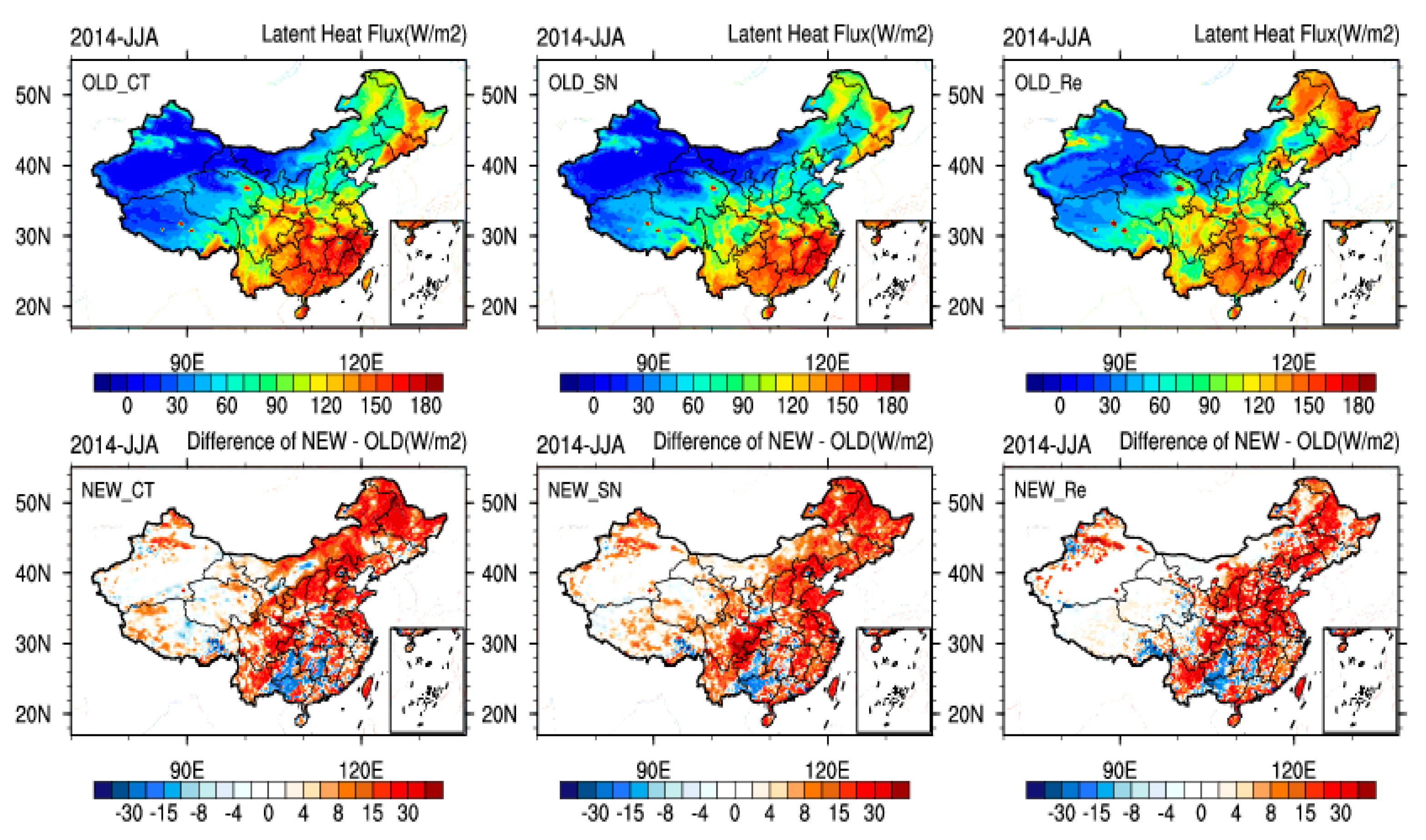1. Introduction
General circulation models (GCMs) are the most commonly used tools for understanding and attributing past climate variations and generating future climate projection. However, their horizontal resolution is often too low to accurately resolve regional or climatic features caused by complex terrain, urban areas, sea-land junctions, and differences in vegetation, land use, and land cover. The downscaling of GCM results or reanalysis data is the main method used to obtain high-resolution regional or local climatic data and establish relationships between global circulation and regional climate [
1].
With the development of regional climate models (RCMs) [
2,
3], dynamical downscaling, which is based on the physical and dynamical frameworks of regional models, has become widely used in downscaling experiments [
4,
5]. Dynamical downscaling typically begins with a set of coarse-resolution large-scale fields from either GCM or global reanalysis data, which are used to provide the initial (ICs) and lateral meteorological and surface boundary conditions (LBCs) to nested RCMs. The traditional dynamical downscaling approach is to conduct a long-term continuous simulation using the RCMs. The RCMs are intended to add regional detail in response to interactions between regional-scale forcing (e.g., topography, coastlines, land use, land cover, and vegetation) and larger-scale atmospheric circulations [
2,
6]. Assuming that the large-scale field is correct, the maximization of retained and added values becomes the focus of dynamical downscaling problems. “Value retained” indicates how well an RCMs maintains agreement with the large-scale behavior of the global model forcing data. “Value added” indicates how much additional information the RCMs can provide beyond the highest-resolution global model output or reanalysis data [
7,
8,
9]. During the dynamical downscaling process, errors are introduced in two primary ways. First, error may be introduced through the limited description of RCMs physical processes, including cloud-related processes, cumulus convection schemes, and land surface-atmosphere interactions. Second, error may be caused by coarse-resolution large-scale fields from GCMs outputs or global reanalysis data, which are used as initial conditions and lateral and surface boundary conditions for the RCMs.
RCMs results may drift away from large-scale forcing fields in the traditional dynamical downscaling approach due to the steady accumulation of errors during long continuous model integrations. Using this method, not enough large-scale value is retained by RCMs dynamical downscaling. To address this issue, nudging techniques have been introduced to RCMs that successfully constrain the growth of error in large-scale circulations and simultaneously allow the free development of small-scale circulations [
10,
11,
12,
13,
14]. Common nudging methods include grid nudging (GN) [
10,
15] and spectral nudging (SN) [
11,
16]. GN, in which Newtonian relaxation is used to adjust the model predictions at individual grid points with the same strength, is developed and applied for retrospective meteorological modeling for air quality applications [
17,
18,
19]. SN imposes time-variable large-scale atmospheric states on a regional atmospheric model [
11]. SN is scale selective and can be desirable in an RCMs because it relaxes only the longer wavelengths in the simulation toward the driving model fields, which allows small-scale variability from the RCMs to develop. SN also minimizes distortion at the lateral boundaries and eliminates the dependence of the RCMs solution on domain size and position [
12,
20]. However, the short-wave information provided by RCMs is believed to be more reliable than that provided by GCMs. Therefore, grid nudging has the risk of over-forcing the RCMs at small scales and SN may theoretically outperform GN [
18,
21,
22]. von Storch et al., reported that the SN method could be successful in keeping the simulated states closest to the driving state at large scales, while generating small-scale features [
11]. By keeping long waves in the nudging term, Miguez-Macho et al., found that SN can simultaneously help eliminate large-scale precipitation bias and maintain small-scale features [
12,
23]. Ma et al., performed downscaling experiments over China, showing that SN produces better dynamical downscaling performance for precipitation [
24]. In addition, the re-initialization method also has proven effective for the acquisition of regional climatic features [
6,
25,
26,
27]. This downscaling method frequently updates the ICs and LBCs and shortens the continuous integration times by running short simulations that are frequently reinitialized. SN and re-initializations have shown excellent downscaling performance in different regions [
18,
24,
27].
In dynamical downscaling, it is critical to obtain as much added value as possible while maximizing the value retained. SN and re-initialization effectively constrain escalating systematic errors during long-term continuous RCMs integrations. Consequently, RCMs can obtain more reliable large-scale circulation features, achieving dynamical downscaling retained value. However, in order to achieve added value, local small-scale features must be embodied in RCMs, which requires RCMs to describe actual atmospheric processes as accurately as possible.
RCMs have significant advantages in the description of local small-scale features because they are coupled with a variety of parameterization processes. Land surface-atmosphere interactions are an important component of the climate system [
28,
29]. Land surface processes control the exchanges of momentum, heat, and moisture between the land surface and atmosphere, which critically affect the RCMs simulation performance; near-surface meteorological fields and boundary layer processes are extremely sensitive to land surface processes [
30,
31,
32]. An accurate treatment of boundary conditions is a central issue in regional modeling [
33,
34,
35]. Static land surface data are important inputs for regional modeling, as they determine pivotal land surface parameters, such as land use and land cover, vegetation fraction, and leaf area index, reflecting the non-uniformity and complexity of the lower boundary. The accuracy of land surface information affects the determination of land surface processes, which in turn affects the performance of models in simulating regional climate. Enhancing the land surface information accuracy improves the description of land surface processes, more accurately reflecting land surface-atmosphere interactions in RCMs, which in turn delivers more valuable small-scale regional information and achieves added value. However, land surface processes are extremely complicated and affected by various factors. Despite active development, the perfection of land-surface models is a difficult and complex task. As the main two land surface parameters, land use and vegetation reflect the characteristics of different underlying surfaces and affect land parameters in the land surface model [
36,
37]. Therefore, during the use of different dynamical downscaling methods, updating the dynamically accordant initial land use and vegetation information is a cost-effective and practical way to improve downscaling results in regional models.
The Weather Research and Forecasting (WRF) model is one of the most widely used regional climate models in dynamical downscaling. It includes two default land use datasets. The first is the Advanced Very High Resolution Radiometer (AVHRR) land use data product developed by the U.S. Geological Survey (USGS) between April 1992 and March 1993, which includes 24 USGS categories [
38]. The second is the MODIS land use data product, which was developed at Boston University between January and December 2001 and includes 20 categories developed by the International Geosphere-Biosphere Programme (IGBP) [
39]. As mentioned above, the accuracy of these land use data products in China is relatively low [
40,
41,
42]. Wu et al., noted that land use and land cover has changed significantly across China since the beginning of the 21st century [
43]. The default vegetation fraction of the WRF model is derived from the 5-year AVHRR normalized difference vegetation index (NDVI) climatology, which covers the period from 1985 to 1990 at a resolution of 0.144° [
44]. Zhao et al., found that the vegetation fraction over China has changed dramatically in recent years [
45]. Li et al., found that compared with the MODIS remote-sensing vegetation fraction, the WRF default vegetation fraction, which was estimated in northeastern China, is becoming gradually less representative [
46]. The studies discussed above show that the land surface characteristics given by the default land use and vegetation fraction data of the WRF are no longer particularly representative over China.
A precondition is hypothesized that both SN and re-initialization methods allow the development of small-scale regional information while maintaining large-scale circulation information, and that accurate land surface data improves the model description of land surface process and increases the added value of dynamical downscaling. Therefore, an unresolved problem lies in whether updating dynamically accordant land surface information of land use and vegetation fraction improves dynamical downscaling performance in different dynamical downscaling methods. This study aims to assess the performance of different dynamical downscaling methods (traditional long-term integrations, spectral nudging, and re-initialization) using updated land surface information. Particular attention is given to obtaining high-resolution climate information over China by the perfect combination of an appropriate dynamical downscaling method and updated land surface information. Several experiments were performed involving two experimental groups. One group is based on the WRF default USGS land surface data, and the other is based on updated 2014 MODIS remote sensing land surface data, which is consistent with the simulation period. Each group consists of three tests involving the traditional, spectral nudging, and re-initialization methods. The tests, which feature grid spacing of 30 km over China, investigate the performance of different dynamical downscaling methods and the contribution of updating dynamically accordant land surface data to ERA-Interim (reanalysis of the European Centre for Medium-Range Weather Forecast, ECMWF) dataset downscaling using the WRF model.
The following
Section 2 describes the land surface dataset, experimental setup, model details, and the observation datasets that are used to validate the downscaling results.
Section 3 presents the results from different dynamical downscaling methods using different land surface datasets. A discussion and summary are presented in
Section 4.
4. Summary and Discussion
The performance of dynamical downscaling is affected by diverse geographical, seasonal, regional climate model, and driven field factors. In this paper, the performance of three dynamical downscaling methods, including the CT, SN, and Re methods, are compared. The effect of updated static land surface information on downscaling performance is also explored for the three dynamical downscaling methods. Two groups of experiments are performed using WRF, one based on the default WRF USGS land use data and AVHRR vegetation fraction data, and the other based on MODIS land use and vegetation fraction data consistent with the selected simulation period. Each group of experiments contains runs using the CT, SN, and Re methods in which dynamical downscaling is performed for ERA-Interim reanalysis data at a resolution of 30 km in the summer of 2014 over China. The downscaling results, which include conventional meteorological elements and precipitation, are evaluated against observation data provided by the NMIC. The mechanisms are examined by which changes in land surface information affect near-surface variables and precipitation in the three dynamical downscaling methods.
The significant conclusions drawn from the 2 m temperature and relative humidity are as follows. The traditional continuous integration approach (CT) shows the worst performance among the downscaling methods. The model drifts away from the forcing ERA-Interim reanalysis over the course of long integrations, and the simulations seriously overestimate surface temperature and underestimate relative humidity (except in the TP region). The SN downscaling simulations perform better than CT, reduces the temperature overestimation and relative humidity underestimation. The Re method has smallest RMSE in 2 m temperature and 2 m relative humidity simulations. In the OLD group, the Re method is more advantageous than the SN method by test of statistical significance (
Table 4 and
Table 5). The precipitation verification shows that all three methods overestimate precipitation south of the Yangtze River. The Re runs feature the most obvious overestimations in the southeast TP, followed by the CT method; the SN method, which constrains error growth in large-scale circulations during long simulations, shows the smallest bias in precipitation magnitude and distribution. The SN method also maintains consistency with the large-scale behavior of the ERA-Interim forcing data higher in the atmosphere.
The default land use and vegetation fraction in the WRF do not accurately reflect the land surface conditions during the analysis period. Compared with the OLD group, the ME, RMSE simulations of temperature and relative humidity are significantly improved in NEW_CT/NEW_SN experiments, and ME is improved in NEW_Re experiments. This effect is especially conspicuous in the CT method, followed by the SN and Re methods. Because the CT method is less constrained by forcing fields in the continuous integration process and is allowed the model to develop freely. The 2 m temperature and relative humidity are more sensitive to changes in land surface information. Therefore, the CT simulations are improved after accurate land surface information is introduced. However, because precipitation is affected by the large-scale circulation field, there is no obvious improvement in precipitation.
The results support this study’s hypothesis that updating accurate land surface information would affect downscaling performance. However, the benefits of updated land surface information for SN and Re methods are not as significant as CT. There are two possible reasons for this. First, when the large-scale information is nudged, the development of small-scale information generated by the land surface information changes is restricted in SN. However, the reason for this is still uncertain, and this topic needs additional research and analysis. Second, in the Re method, the initial field is frequently updated and fails to reflect the cumulative effect of updating land surface information on the climate field. Future studies will explore a method to reduce this drawback.
The heterogeneity and complexity of a land surface is characterized by various land surface information parameters in the model land surface processes. Therefore, in order to more accurately reflect land-atmosphere interactions, accurate initial land surface information is introduced in a regional model to obtain more valuable small-scale regional information. This, in turn, achieves greater added value through dynamical downscaling, which is a cost-effective and practical approach to improve the dynamical downscaling performance of different methods. Therefore, it is necessary to create dynamically accordant initial land surface data sets consistent with the downscaling experiment analysis period.
